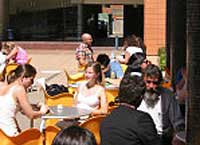|
||||||||||||||||||||||||||
| Linguistics - LINGA23525 | ||||||||||||||||||||||||||
This plan is only available to student commencing 2009 onwards
Linguistics is the study of human language. The minor in Linguistics addresses questions such as: How do people use language in various situations? What is the biological basis for language? Is language unique to the human species? How and why do languages change? How do children learn language? What is the meaning of ‘meaning’? Can machines talk? How does language relate to other modes of communication? Linguistics also provides the basis for a variety of practical applications including, at UNSW, the teaching and learning of foreign languages, translating and interpreting, facilitating cross-cultural communication, developing language curricula in schools, and improving literacy skills. Aims of the Minor The aims and objectives of the BA Minor in Linguistics relate to two areas, knowledge and skills: Knowledge: 1. To foster an understanding of the nature of a linguistic theory, of the core analytical concepts relevant to each area of analysis. 2. To develop an understanding of the place of language in the interdisciplinary study of the cognitive sciences (including cognitive psychology, sociology, cognitive anthropology, neurology, and artificial intelligence). 3. To recognise the technical and ethical issues involved in the collection and documentation of data from language consultants in the field or from subjects in the experimental laboratory. 4. To demonstrate an understanding of the scientific method through the critical evaluation of the relationship between linguistic data and linguistic theory, in particular the central role of hypotheses and the testing of hypotheses; 5. To demonstrate an understanding of the relationship between social, educational and cultural issues and such topics as the analysis of spoken and written text, the analysis of sentences and clauses, the analysis of vocabulary, the study of standard and non-standard language and the processes of standardisation, the analysis of spoken interaction, the investigation of literacy practices. 6. To show how the language situation in contemporary Australia is located within an historical and comparative context. 7. To engage critically with fundamental linguistic questions about value in both ethical and aesthetic contexts. Skills: 1. To plan, design and execute a piece of research or an inquiry. 2. To communicate ideas about language in writing or by oral presentation. 3. To evaluate and challenge conventional doctrines through the articulation of novel research questions. 4. To develop the ability to incorporate findings from other disciplines. 5. To search out, synthesise and discuss information stored on paper, electronically or visually. 6. To develop the skills of critical, creative and imaginative thinking about the role of language in society, culture and the arts. A student who wishes to gain a Minor in Linguistics must complete 36 units of credit including 12 uoc at Level 1, at least 12 uoc at Level 2 and at least 12 uoc at Level 3.
Level 1
Level 2
Level 3
Level 3 courses cover key issues and debates in contemporary Linguistics in the following areas: language universals and linguistic typology, generative grammar, sociolinguistics, and English grammar |
||||||||||||||||||||||||||



